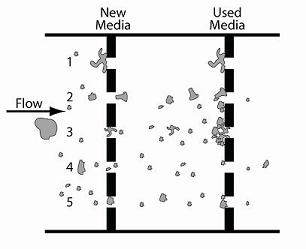The useful life of most media filters is determined by the size and quantity of particles they capture. Each filter has only a limited number of sites to trap particles. Once a site traps a particle, flow through that site’s passage is either reduced or stops completely. When a sufficient number of sites are blocked, flow through the filter as a whole is reduced to the point that the media must be replaced to restore adequate flow to the system.

In the beginning, a filter media captures primarily particles larger than its specified rating. Assuming that there is a distribution of particles of varying sizes, however, sites partially blocked by irregular shaped particles or fibers eventually become finer filters blocking progressively smaller and smaller particles until flow is severely reduced even if the percentage of particles that are actually larger than the rating of the filter is relatively small.
The tendency of particles to collect and lodge in a filter site depends on their size, shape and their ability to entangle with one another. Particles that are typically smooth and spherical are less likely to lodge in a filter site than those that are spiral or “C” shaped. Particles that have a large width to length ratio are less likely to restrict flow through a site than those that are better described as “flakes.” Particles also vary in “stickiness” and this property also has an effect. Particles of wax, rosin and many plastics could be considered “sticky.”
If it is known in advance that the process produces an abundance of large particles, the media selected should be designed to accommodate a large volume of large particles. If, on the other hand, it is known that there will be particles of a wide range of sizes and the goal is to filter out all but the very smallest particles, the media selection will be entirely different. Other attributes described above may also be worthy of consideration. There are specialized filters and media available for each application. Upcoming blogs will explain the various types of filters and filter media.
In the previous blog, the importance of knowing the size and shape characteristics of the particle population was discussed. Based on tha above, part of this analysys, then, should also be an understanding of the particle size distribution in the liquid being filtered and the physical nature of the particles to be removed by the filter. The filter media selected may have a significant impact on filter life depending on the particle size, distribution and other physical properties.



 English
English Spanish
Spanish Chinese
Chinese Canada
Canada Mexico
Mexico United Kingdom
United Kingdom



